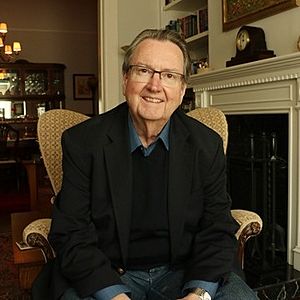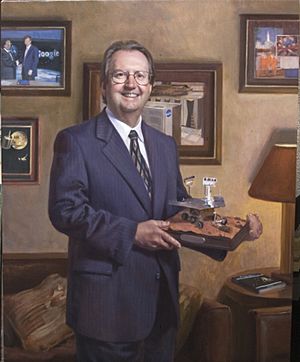G. Scott Hubbard facts for kids
Quick facts for kids
G. Scott Hubbard
|
|
|---|---|

Hubbard in 2020
|
|
| Born | December 27, 1948 Lexington, Kentucky U.S.
|
| Other names | Scott Hubbard |
| Alma mater | Vanderbilt University University of California, Berkeley |
| Known for | Restructuring NASA's Mars Program, known as the first "Mars Czar" |
| Awards |
|
| Scientific career | |
| Fields | Aeronautics and Astronautics |
| Institutions | Lawrence Berkeley National Laboratory, NASA, Stanford University |
G. Scott Hubbard (born in 1948) is a physicist who has spent over 45 years working in space research. He worked for NASA for 20 years, eventually becoming the director of NASA's Ames Research Center.
Hubbard was NASA's first director for the Mars program. He helped fix the Mars program after some missions failed. He also served on the board that investigated the Columbia accident. Today, he leads the Safety Advisory Panel for SpaceX.
Contents
Scott Hubbard's Early Life
Scott Hubbard was born in Lexington, Kentucky. He spent most of his childhood in Elizabethtown, Kentucky. His dad was a judge, and his mom worked for the local visitor commission.
Hubbard's interest in space began when he was about nine years old. This was when Sputnik first orbited Earth. His father brought home a small refracting telescope, and they used it to look at the night sky, especially Mars.
He loved reading science fiction and books about astronomy and cosmology. This early interest later led him to study astrobiology, which is the study of life in the universe.
Music and Science
Around the same time, Hubbard's father also brought home a ukulele. He quickly learned to play it and later moved on to the guitar. He taught himself by listening to famous folk musicians like Woody Guthrie and Bob Dylan.
From then on, space and music were both very important to him. He played guitar throughout his college years and even as a full-time musician for a while. Even though he chose rocket science as his career, he never stopped playing music for fun.
Education and Learning
In 1966, Hubbard graduated from Elizabethtown High School as the top student. He received many scholarship offers. He chose to attend Vanderbilt University in Nashville, Tennessee. There, he studied both physics and astronomy.
Later, from 1975 to 1977, he did his graduate studies at the University of California, Berkeley. He focused on how materials like semiconductors behave. In 2006, he received a special Doctor of Science degree from the Technical University of Madrid. This honor was given to him because of his many professional achievements.
Career in Space and Science
Before joining NASA, Scott Hubbard worked at the Lawrence Berkeley National Laboratory. He also helped start a high-tech company called Canberra Semiconductor. He was also a senior research physicist at SRI International.
Leading NASA's Mars Program
At NASA, Hubbard became the first director of the Mars Exploration Program. He was sometimes called the "Mars Czar." He completely reorganized the program after some missions had failed.
He also helped create the NASA Astrobiology Institute. He came up with the idea for the Mars Pathfinder mission, which used airbags to land safely on Mars. He also managed NASA's Lunar Prospector Mission.
Director of Ames Research Center
From 2002 to 2006, Hubbard was the director of NASA's Ames Research Center. During his time there, he helped create two important partnerships.
In 2004, NASA launched the "Columbia" supercomputer at Ames. This was one of the most powerful supercomputers in the world at the time. It was built with Silicon Graphics, Inc. and Intel. This powerful computer helped scientists predict hurricanes three days earlier, which could save lives.
Hubbard also brought together Ames Research Center and Google in 2005. They planned to work together on things like managing huge amounts of data and encouraging new space businesses. Eric Schmidt, Google's CEO at the time, said they both wanted to bring "a universe of information to people around the world."
Hubbard has received many awards from NASA, including their highest honor, the Distinguished Service Medal.
After NASA
In 2014, Hubbard worked for the B612 Foundation. This group is dedicated to protecting Earth from asteroid strikes. It includes many scientists, former astronauts, and engineers.
After leaving NASA, he joined Stanford University. He worked in the Aeronautics and Astronautics department. He also helped create Stanford's Center of Excellence for Commercial Space Transportation. He was also the first editor of a science journal called New Space.
Since 2012, Hubbard has led the Safety Advisory Panel for SpaceX. This panel includes famous astronauts like Leroy Chiao and Mark Kelly.


